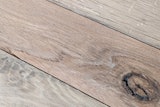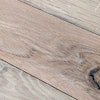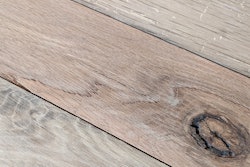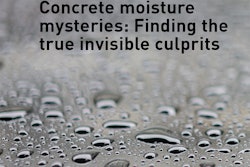Surprise Cupping
I replaced a very old solid oak strip wood floor with a new solid wood floor. The new floor started cupping almost immediately after I installed it, but the old floor was fine. Why would this happen?
Matt Skowron, owner at Lake City, Fla.-based The Floor Detective, answers:
Every now and then I inspect new wood floors that have replaced old wood floors. Just as in your case, the old floor has been there for decades without incident. The new floor, however, cups or has other issues, and the homeowner thinks it must be bad wood. Typically, when you look at the installation, you see the floor is over a 12-inch crawl space with little to no ventilation and no plastic on the soil. When you try to explain that the crawl space does not meet National Wood Flooring Association standards, the homeowner points out that the old floor was just fine over that crawl space, so there must be something wrong with the new wood.
The homeowner points out that the old floor was just fine over that crawl space, so there must be something wrong with the new wood.
What people don’t realize is that the old floor did all of its cupping, twisting, etc.—if any—40 years ago or whenever it was installed. It settled down and was sanded and refinished. It then lived happily in its environment for the next 40 years because it was in equilibrium with its surroundings. The new wood is thrown into this new environment and it has not had a chance to adapt yet. Oftentimes, if you let the floor sit for a year, go through four seasons of heating and cooling (for those places that have four seasons), it will gradually come into equilibrium with its environment and the cupping, etc., will subside. If it does not subside completely, you can then sand and refinish, providing you have enough depth of wood to sand.
RELATED: Wood Floor Cupping: Why Does it Happen & What Can You Do?
OK to Add Water?
Do any of the waterborne finish manufacturers say it’s OK to add water to their waterborne finish to make it roll out better with a roller? I find many two-component finishes don’t want to flatten out.
Brett Miller, VP of education and certification at the NWFA, answers:
Whether or not you can add water to a waterborne finish is completely product-specific. Each manufacturer will have different instructions for each product. The same goes for the applicators—some waterborne finishes can be rolled and some can’t, and the directions might not be the same for all products from a manufacturer.
When manufacturers indicate it is OK to add water to their waterborne finish, it is to add a little more time for the finish to flow and level in challenging conditions. Since waterborne finishes that can be rolled are typically more viscous, I wouldn’t think that adding water to a finish would improve its ability to be applied with a roller. Again, this is completely product- and manufacturer-specific, and some may tell you it’s OK.
If you are having issues with your waterborne finish drying too fast, first remember your basics about job-site conditions when applying finish. Have you limited air movement across the floor as much as possible? Is the floor or the air too hot? Is the finish acclimated to the job site? Air movement and heat will both accelerate drying, which can cause problems with flow and leveling.
Cupping Culpability
A solid floor I recently installed started showing cupping not long after installation. I think I got bad wood from the manufacturer, but they say it’s my fault. Who is right?
Wil Maxwell, director of operations at Monticello, Ark.-based Maxwell Hardwood Flooring, answers:
To find out who is responsible, you would need to hire a wood floor inspector. Generally, by gathering the moisture content of the floors and current width, one should be able to determine the cause of a moisture-related problem. Either the flooring was inaccurately dried and milled, or an outside influence of moisture occurred during or after installation.
That said, in today’s wood flooring market, it is very unlikely that wood flooring left a reputable wood flooring mill with the wrong moisture content, because technological advancements in moisture detection have dramatically improved flooring MC. During the manufacturing process, hardwood lumber is dried to the desired MC of 6–9 percent. Green lumber is stacked, allowing airflow and heat to wick away moisture. There are different methods for drying hardwood lumber, but eventually all lumber is placed in kilns during the final stage of drying. This process is meticulous, with sampling and testing throughout to ensure uniform curing of the lumber. As lumber enters the milling process, most operations have moisture detection systems designed to remove any lumber outside the desired MC. Flooring is then boxed or wrapped to protect it from environmental changes during warehousing or shipping.
RELATED: Understand Wood Floor Moisture Content & Dimensional Change
In the future, you can make sure the wood is at the correct MC when it arrives by checking multiple boards with a moisture meter (be sure to record your findings). Installation is a pivotal time in respect to moisture. The flooring should be allowed to acclimate to the average conditions it will experience long-term in the home. Humidity levels of 35–55 percent in the home are desired, but not all homeowners will maintain their homes at that level. This is information you need to know before you begin your installation.

































